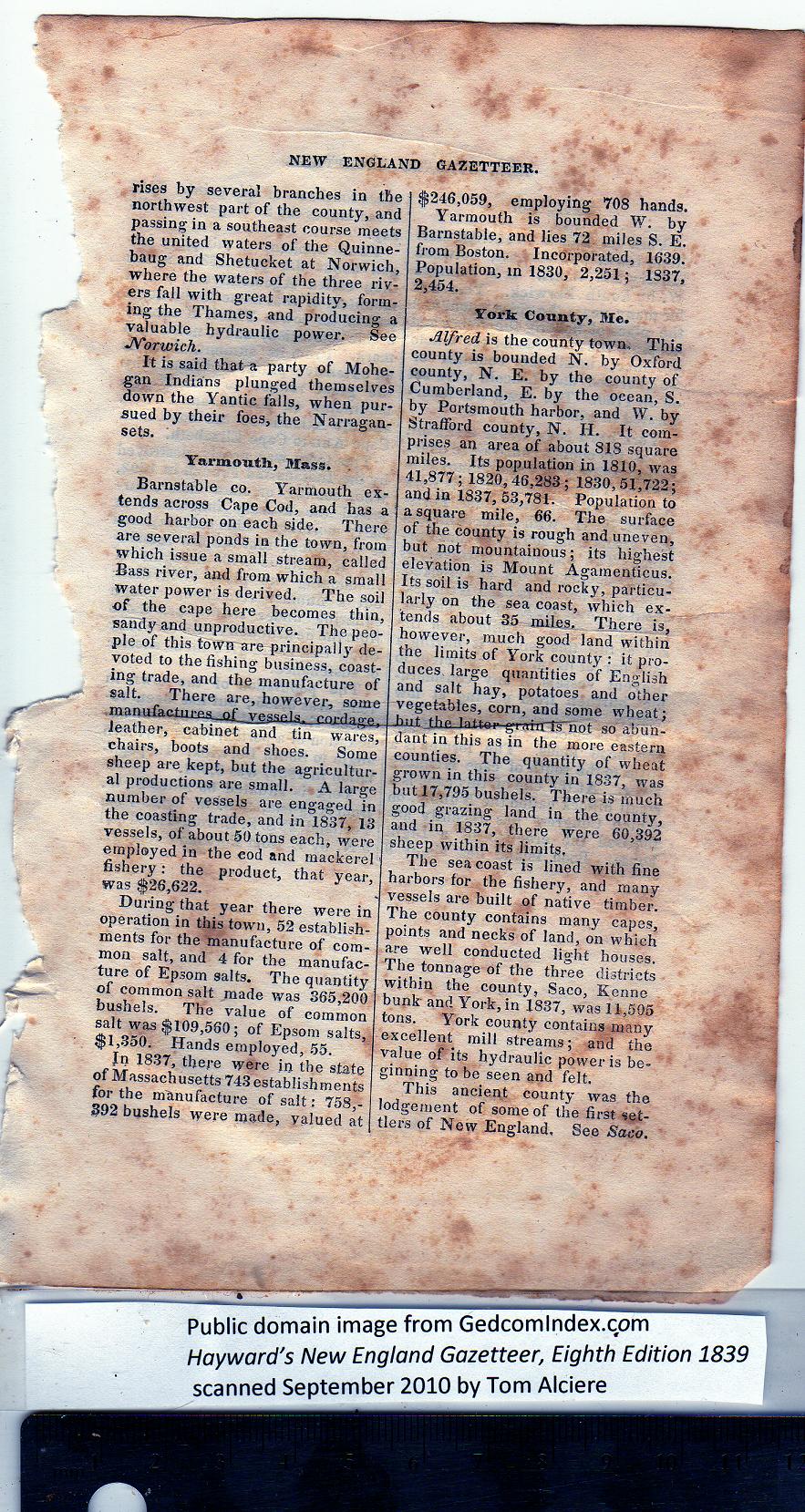|
rises by several branches in the
northwest part of the county, and
passing in a southeast course meets
the united waters of the Quinne-
baug and Shetucket at Norwich,
where the wafers of the three riv-
ers fall with great rapidity, form-
ing the Thames, and producing a
valuable hydraulic power. See
Norwich.
It is said that -a party of Mohe-
gan Indians plunged themselves
down the Yantic falls, when pur-
sued by their foes, the Narragan-
sets.
Yarmouth, Mass.
Barnstable co. Yarmouth ex-
tends across Cape Cod, and has a
good harbor on each side. There
are several ponds in the town, from
which issue a small stream, called
Bass river, and from which a small
water power is derived. The soil
of the cape here becomes thin,
sandy and unproductive. The peo-
ple of this town are principally de-
voted to the fishing business, coast-
ing trade, and the manufacture of
salt. There are, however, some
mannfaediirpq nf rnrdngPt,
leather, cabinet and tin wares,
chairs, boots and shoes. Some
sheep are kept, but the agricultur-
al productions are small. A large
number of vessels are engaged in
the coasting trade, and in 1837, 13
vessels, of about 50 tons each, were
employed in the cod and mackerel
fishery: the product, that year,
was $26,622.
During that year there were in
operation in this town, 52 establish-
ments for the manufacture of com-
mon salt, and 4 for the manufac-
ture of Epsom salts. The quantity
of common salt made was 365,200
bushels. The value of common
salt was $109,560; of Epsom salts,
$1,350. Hands employed, 55.
Jn 1837, there were in the state
of Massachusetts 743 establishments
for the manufacture of salt: 758,-
392 bushels were made, yalued at |
$246,059, employing 708 hands.
Yarmouth is bounded W. by
Barnstable, and lies 72 miles S. E,
from Boston. Incorporated, 1639.
Population, in 1830, 2,251; 1S37,
2,454.
York County, Me*
Alfred is the county town. This
county is bounded N. by Oxford
county, N. E. by the county of
Cumberland, E. by the ocean, S.
by Portsmouth harbor, and W. by
Strafford county, N. H. It com-
prises an area of about 818 square
miles. Its population in 1810, was
41,877; 1820,46,283; 1830,51,722;
and in 1837, 53,781. Population to
a square mile, 66. The surface
of the county is rough and uneven,
but not mountainous; its highest
elevation is Mount Agamenticus.
Its soil is hard and rocky, particu-
larly on the sea coast, which ex-
tends about 35 miles. There is,
however, much good land within
the limits of York county : it pro-
duces large quantities of English
and salt hay, potatoes and other
vegetables, corn, and some wheat;
hut .thnJattee-grrrrrrTThot so abun-
dant in this as in the more eastern
counties. The quantity of wheat
grown in this county in 1837, was
but 17,795 bushels. There is much
good grazing land in the county,
and in 1837, there were 60,392
sheep within its limits.
The sea coast is lined with fine
harbors tor the fishery, and many
vessels are built of native timber.
The county contains many capes,
points and necks of land, on which
are well conducted light houses.
The tonnage of the three districts
within the county, Saco, Kenne
bunk and York, in 1837, was 11,505
tons. York county contains many
excellent mill streams; and the
value of its hydraulic power is be-
ginning to be seen and felt.
This ancient county was the
lodgement of some of the first set-
tlers of New England, See Saco. |
